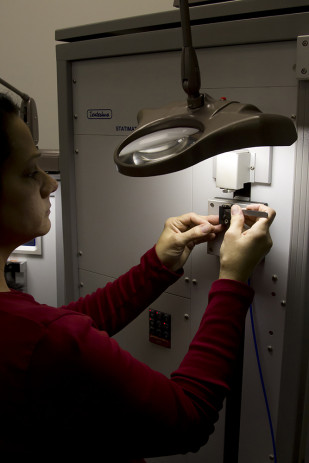The Textile Center has two physical testing labs that house over $1 million worth of equipment that make it possible to perform a wide variety of physical testing on fibers, yarns, and fabrics.
- Fibers can be singled out and analyzed for size, breaking strength, elongation, staple length, and other attributes.
- Yarns may be processed through the latest generation Uster machines for a thorough look at the quality of your product. Yarns may also be tested for shedding, turns per inch, and more.
- Fabrics can be analyzed for content and construction by breaking them down into yarn or fiber form and running tests or they can be tested in fabric form for ball burst, tear strength, pilling, shrinkage and more. In addition we can analyze the fabric and determine the weave or knit patterns used to produce the fabric.
Please contact the Physical Testing Lab to discuss your physical testing needs.
Monét Freeman ~ 704-825-6288 /freeman.monet@gaston.edu
Alicia Stevenson ~ 704-825-6288 /stevenson.alicia@gaston.edu
Services Offered
Fiber Testing
- Rotor Ring
This Rotor Ring instrument measures fiber-to-fiber and fiber-to-metal opening energy to monitor changes in staple fiber cohesion. - Fiber Diameter Synthetic
DPF, or Denier per Filament is the method which covers the determination of denier to all types of yarn with less that 5% stretch. - Favimat Fiber Breaks
(ASTM D1577) Favimat is a semiautomatic controlled tensile tester which works according to the principle of constant rate of extension with integrated measuring head for fineness measurement. - AFIS
(ASTM D5866) Advanced Fiber Information System, provides an improved method of collecting fiber information on fiber quality. It measures “single” fibers and provides data and distributions of measured properties for length and neps. - Crimp per inch
(ASTM D3937) This test for determination of crimp frequency of manufactured staple fibers may be used for the acceptance testing of commercial shipments. - Moisture Balance
(ASTM D7404) – This method is used to measure the amount of time it takes for water to dissipate from fabric. - Staple Length
(ASTM D5103) This method covers the determination of average staple length and staple length distribution of both manufactured and natural fibers by manually measuring single fiber length.
Yarn Testing
- Uster UT-4/6 %CV Sliver
Determines the number of imperfections in a yarn. It provides statistical evaluations of polyester blended yarns for classification of evenness, thickness, thinness as well as neps. - Twist per Inch-Plied
(ASTM D1423) This test method covers the determination of the twist of the plied yarns and the twist of the single yarn before plying. - Skein Breaks
(ASTM D1578) This test covers the determination of the breaking strength of yarn in skein form. The observed breaking strength is expressed in units of force, and equations are provided to convert breaking strength to skein breaking tenacity and to skein break factor. - Short Length Denier
(ASTM D1059) – This test method covers the determination of the yarn number taken from any textile fabrics in which the yarns are intact and can be removed in measurable lengths. Because this method is based on short-length specimens, the results should only be considered as approximations of the yarn number. - Instron Yarn Breaks single end (n=10)
(ASTM D2256) This test conditions for determining the tensile properties of yarns using the single strand method. - Boiling Water Shrinkage
(ASTM D2259) This test method covers the measurement of shrinkage of yarns that has been exposed to boiling water. Skeins are made from yarn and immersed into boiling water. Skeins are reconditioned and measured for shrinkage. - Hot Air Shrinkage
(ASTM D2259) This test method covers the measurement of shrinkage of yarns that has been exposed to hot air. Skeins are made from yarn and exposed to dry heat. Skeins are reconditioned and measured for shrink- age.
- Node Count
This method determines a node count in a filament yarn. - Spinning Process ID
Determine how the yarn is spun. Ring, Open End or Air Jet. - Statimat
(ASTM D2256) This test method covers the determination of tensile properties of monofilament, multifilament, and spun yarns. - Twist per Inch-Singles
(ASTM D1423) This test method covers the determination of the amount and direction of twist at the completion of any stage of twisting in single (spun or filament) yarns. - Yarn Denier/Count
(ASTM D1059) This test covers the determination of the yarn number of all types of cotton, woolen, worsted, and man-made fiber yarns taken from packages; or from any textile fabrics in which the yarns are intact and can be removed in measurable lengths.
Fabric Testing
- Twist per Inch (Fabric)
(ASTM D1423) This test determines the amount and direction of twist at the completion of any stage of twisting in single (spun or filament) yarns taken from fabrics. - Tongue Tear
(ASTM D2261) This tests method covers the measurement of the tearing strength of textile fabrics by the tongue (single rip) procedure. - Thickness
ASTM D1777 Covers the measurement on the thickness of most textile materials. - Shrinkage (Fabric)
(AATCC Test Method 135) This test method is intended for the determination of dimensional changes of fabrics when subjected to home laundering procedures used by consumers. - Ring Pull
Mechanical test that quantifies hand of a fabric. - Plastic Replica
Determines if defects in a fabric such as streaks and barre are caused by physical or dye defects. - Home Laundering 5 wash
Five Home Laundering washings in standard washing machine. - General Physical Testing Prep
If additional preparation is necessary to complete primary testing. - FAK Sampler Knitting Machine
Knits sample sizes in tubular knit with one cone of yarn. Yarn type dictates hourly price. - Fabric Construction Analysis
Visual determination of weave process, fabric weight, fabric thickness thread count and denier. - Elmendorf Tear
(ASTM D1922) A pendulum impact tester is used to measure the force required to propagate an existing slit a fixed stance to the edge of the test sample. - Crocking
This test method describes the transfer of color from one fabric onto another white test fabric. It is to test improper dyeing, poor penetration, or poor fixation. - Ball Burst
(ASTM D6797) This test method describes the measurement for burst- ing strength of woven and knitted textiles taken from rolls of fabric or fabric taken from garments. - Absorbency
(AATCC 79) This test method is designed to measure the water absorbency of textiles by measuring the time it takes a drop of water placed on the fabric surface to be completely absorbed into the fabric. - Computer Color Measurement
The Color Eye specializes in color management and color communication L,a,b technology. It offers digital solutions for color management, color matching, quality control, and color communication from production to marketing. - Cut TDM100
(ASTM F2992-15) This test method covers the measurement of the cut resistance of a material when mounted on a mandrel and subjected to a cutting edge under a specific load. - Fabric Appearance
(AATCC 124) This test method is designed to evaluate the smoothness appearance of flat fabric specimens after repeated home laundering. - Fabric Weight
(ASTM D3776) These test methods cover the measurement of fabric mass per unit area (weight) and is applicable to most fabrics. - Filament Count
Determine filament count within a yarn. - Grab Strength
(ASTM D5034) This test method covers the grab and modified grab test procedures for determining the breaking strength and elongation of most textile fabrics. - Random Tumble Pilling
(ASTM D3512) This test method covers the resistance to the formation of pills and other related surface changes on textile fabric - Seam Slippage
(ASTM D1683) Used to determine either the sewn seam strength of textiles or the efficiency of a seam assembly with any given fabric. - Strip Strength
(ASTM D5035) This test method covers raveled strip and cut strip test procedures for determining the breaking force and elongation of most textile fabrics. Provision is made for wet testing. - Thread Count (Fabric Construction)
(ASTM D3775) The measurement of warp end count and filling pick count and is applicable to all types of woven fabrics. - Trapezoid Tear
(ASTM D4533) This test method is an index test used to measure the force required to continue or propagate a tear in woven or non-woven geo- textiles by the trapezoid method. - Vertical Wicking
(AATCC Test Method 197) This test method is used to evaluate the ability of vertically aligned fabric specimens to transport liquid along and/or through them, and is applicable to woven, knitted, or non-woven fabrics. - Whiteness Measurement
(AATCC Test Method 110) This test method pro vides procedures for measuring the whiteness and tint of textiles.
Abrasion Testing
- Tabor Abrasion
(ASTM D4060) This test method covers the determination of the abrasion resistance of organic coatings to abrasion produced by the Tabor Abraser on coatings applied to a plane, rigid surface, such as a metal panel. - Martindale Abrasion
(ASTM D4966) This test method covers the determination of the abrasion resistance of textile fabrics abraded against crossbred, worsted wool fabric. - Wyzenbeek
(ASTM D4157) This test method covers the determination of the abrasion resistance of woven textile fabrics using oscillatory cylinder tester. The specimen is abraded using cotton duck #10 and evaluated visually.



